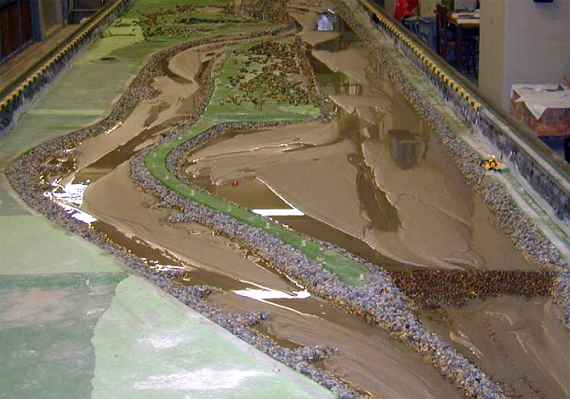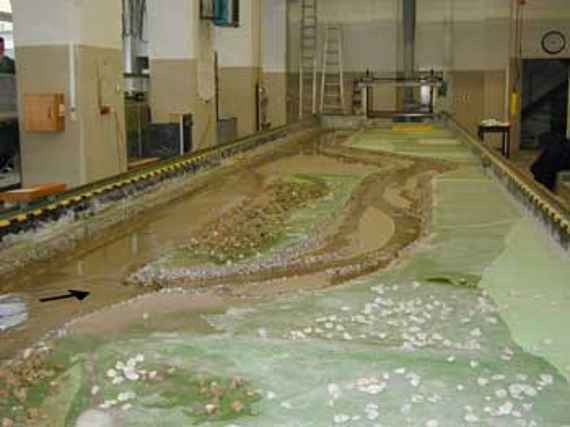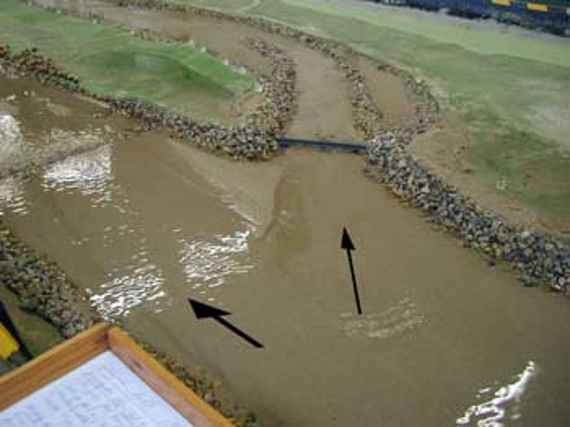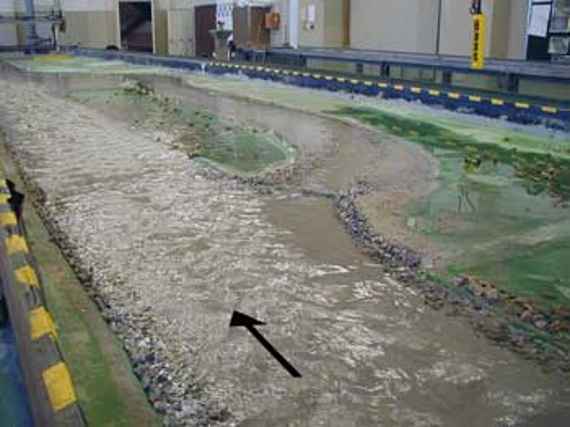The project "Bed load Trap Hornberg - Ehenbichl" aims at balancing the bed load transport of the river Lech in the area of Lechaschau and Reutte in Tyrol, thus, ensuring flood protection and also significantly improving the ecologic functionality of the project stretch due to an insufficient flood protection caused by a river bed aggradation.
This aggradation tendency regularly entailed large, ecologically disputed bed load dredging Since each bed load dredging also means unfavourable effects on the river ecosystem, notably in an ecologically valuable area such as the river Lech, a sustainable solution both ecologically and hydraulically satisfying was needed.
To achieve a solution which, on the one hand, minimizes human influences on the river ecosystem and does not interrupt the flow continuum, and, on the other hand, also approaches to the natural, braided river morphology, the river was planned to be divided into two channels. One channel works as a bed load entrapment only for high discharges. The second channel, forwarding the bed load according to the sediment transport capacity of the downstream river reach, works like a bypass to the deposition zone and remains untouched by the dredging. Hence, the concept achieves both the morphological dynamic equilibrium of the downstream river reach and reduced human influences on the river ecosystem. The bed load entrapment was planned to be situated upstream of the endangered aggradation area. On the upstream and downstream end, the bed load entrapment is bordered by two ramps. The second channel - the diversion channel - starts upstream of the upper ramp and meets the River Lech again downstream of the second ramp.
Thus, the length of the diversion channel arises to almost 1000 m. The upper ramp situated at km 183.397 provides a stable head water level for the inflow into the diversion channel. The lower ramp situated at km 182.775, bordering the bed load entrapment at the downstream end, reduces the flow velocity inside the entrapment area which leads to a controlled bed load deposition. The river bed widening between the two ramps additionally reducing flow velocity and bed shear stress is to increase the retention area.
The inflow into the diversion channel is limited by a discharge throttle. Discharges lower and equal to the mean flow are forwarded solely to the diversion channel. Discharges higher than the mean flow corresponding to high bed load also flow through the bed load entrapment. Since the bed load entrapment runs dry during low water periods, e.g. during the winter, when the whole discharge flows through the diversion channel the dredging can be limited to these periods causing only little unfavourable effects on the river ecosystem.
The whole design of the bed load entrapment is based on an optimal discharge and bed load distribution between the two channels. This discharge and bed load distribution mainly depends on the crest height of the upper ramp, on the dimensions of the discharge throttle as well as the position of groynes to direct the flow of water and sediment. Since all these influencing variables were expected to cause highly complex interactions, it was decided to highlight the problem by conducting a physical model test. The model mainly focused on possible control elements such as the discharge throttle or dikes and groynes in the upstream river reach and the bypass to influence the discharge and bed load distribution and transport depending on the geomorphologic boundary conditions.
The modelled river section had a length of 1,573 m and a width of 220 m in nature. According to the available space of the laboratory flume the scale factor of the physical model was fixed at 1 to 80. This scale factor does not allow quantitative but qualitative assessments of morphological results, since the morphological transport processes in nature do not exactly correspond to transport processes in the physical model.
The bed load entrapment was optimised within more than 20 experiments varying the crest height of the ramps and ramp heights, the size and height of the slot of the discharge throttle as well as position and layout of different measures to direct the flow and the bed load upstream of the diversion structure. The model results indicated that the deposited material amounted to approximately 55 % of the total bed load for an average year. This means that 45 % of the total bed load material satisfied the transport capacity of the downstream river reach since the model results adding up all experiments exhibited bed levels being in a morphological dynamic equilibrium.
However, stochastic factors like discharge regime or saturation level of the sediment transport capacity affect bed load transport and deposition processes. Hence the permit planning is complemented by a complex river bed stability and bed load monitoring program.
In the course of the experiments, special attention was paid not only to the hydraulic engineering requirements but also to the aquatic ecology of the mean water channel. In cooperation with experts from ARGE Limnology, ecologically valuable river areas were defined and designed. The results of this cooperation were integrated into the project results.
Physical Model at mean water discharge Q = 45 m³/s;
left channel bed load trap, right channel bypass channel
Inflow into the diversion channel with training dikes and discharge throttle
Physical model at a 100-years flood (HQ100 = 762 m³/s)




